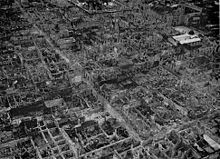- Manila massacre
-
The Manila massacre refers to the February 1945 atrocities conducted against Filipino civilians in Manila, Philippines by Japanese troops during World War II.
Contents
Description
To avoid needless violence and civilian deaths[citation needed], and also to preserve as large a force as possible to continue defensive operations in rural Luzon, Imperial Japanese Army General Tomoyuki Yamashita had ordered a complete withdrawal of Japanese troops from Manila. However, 10,000 marines under Vice Admiral Sanji Iwabuchi disobeyed Yamashita's orders[citation needed] and remained in Manila along with some IJA stragglers.
Various credible Western and Eastern sources agree that the death toll was at least 100,000,[1] tallying to around 10% of the population of the city. The massacre was at its worst in the Battle of Manila, in which the Allies bombed the city of Manila to drive out the Japanese. By the time the Japanese were driven out, the city was in ruins, becoming the second most destroyed Allied capital city during the war, the first being Warsaw in Poland.[2] During lulls in the battle for control of the city, Japanese troops took out their anger and frustration on the civilians caught in the crossfire. Japanese troops looted and burned, and brutally executed, decapitated and abused women, men and children alike, including priests, Red Cross personnel, prisoners of war and hospital patients.
The Manila massacre was one of several major war crimes committed by the Imperial Japanese Army, as judged by the postwar military tribunal. Although General Yamashita had ordered all Japanese forces under his command to withdraw from Manila, and had no control over those who chose to disobey his orders, he was nonetheless judged to be responsible and executed. The Yamashita standard -regarding a commander's responsibility for action taken by anyone under his command- is based upon his trial. This decision is controversial even today.
See also
- Bataan Death March
- Japanese Massacre of De La Salle Brothers
- Akira Mutō
Notes
- ^ White, Matthew. "Death Tolls for the Man-made Megadeaths of the 20th Century". http://users.erols.com/mwhite28/battles.htm#Manila. Retrieved 2007-08-01.
- ^ Quezon, Taylor (7 February 2007). "The Warsaw of Asia: How Manila Was Flattened in WWII". Arab News. http://archive.arabnews.com/?page=7§ion=0&article=91871&d=7&m=2&y=2007. Retrieved 25 January 2011.
References
- Taylor, Lawrence. A Trial of Generals. Icarus Press, South Bend IN, 1981
- Quezon, Taylor (7 February 2007). "The Warsaw of Asia: How Manila Was Flattened in WWII". Arab News. http://archive.arabnews.com/?page=7§ion=0&article=91871&d=7&m=2&y=2007. Retrieved 25 January 2011.
External links
- WW2DB: The Philippines Campaign
- The Battling Bastards of Bataan
- The Historical Atlas of the Twentieth Century by Matthew White
Categories:- World War II massacres
- Massacres in the Philippines
- Massacres committed by Japan
- History of Manila
- 1945 in Japan
- 1945 in the Philippines
- Conflicts in 1945
- War crimes in the Philippines
- Military history of the Philippines during World War II
Wikimedia Foundation. 2010.



